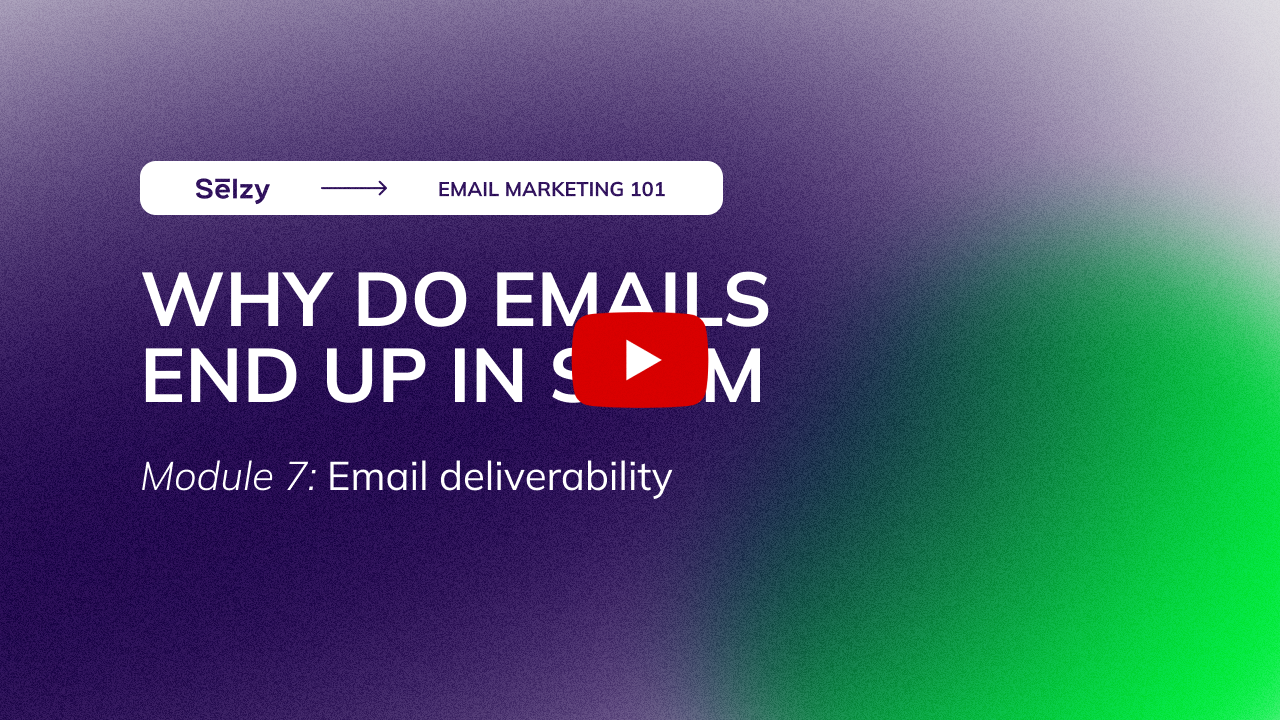Why Do Emails End Up in Spam, Even If You're Not a Spammer?
This is a transcript of lesson 17 of Email Marketing 101 Course by Selzy.

Hello! Welcome to another module of our email marketing course! In this module, we will talk about:
- Why emails end up in spam
- What steps will land your emails in the inbox
- What you can do if the worst comes to worst and you find your emails in spam anyway
But before we start — well done to you! If you’ve clicked on this video, you’re already doing more for your email marketing than most people. Most senders don’t worry about their emails landing in spam until they have a major issue that becomes obvious — like when hundreds or thousands of emails fail to reach customers. If it’s not your case, great, it’s always better to be proactive than reactive!
As much as 7% of all emails worldwide go to spam. For a mailing list with 1,000 subscribers, this would mean 70 emails lost in the spam or junk folder. It may not seem like much. But that’s 70 people who won’t hear about your offers and won’t convert to paying customers. And what if, among those 70, there were 10 that were REALLY ready to buy but they just didn’t get that chance? Sounds like there’s a real problem here. When it comes to deliverability problems, the issue isn’t only that some people aren’t getting your message, it’s that you don’t know which subscribers aren’t getting your email!
The good news is that you can easily prevent going to spam if you know why this happens. Sometimes emails get marked as spam due to technicalities that you just need to pay attention to.
So, here are the 5 possible reasons why emails end in spam:
The email looked like spam.
Bad list hygiene.
Bad sender reputation.
Individual spam filters set by the subscriber in their inbox.
A mistake on the email service side.
Now, let’s talk about each of these things in detail!
Reason #1: Your email looks like spam to a spam filter
This includes e.g. the visuals and some technical elements, like links in the text.

This visual is only available in a video lesson
Here’s what a typical spam email looks like.

This visual is only available in a video lesson
This example is an obvious scam. Why would someone be giving away hundreds of thousands of pounds to random people, right? And while the sender asks for relatively harmless data, some spammers will ask for credit card information or passwords.
In general, any personal data request, even as innocent as the one above, is a major red flag.
Now, back to your email.

This visual is only available in a video lesson
It might have included too many links, shortened links, or an irrelevant attachment. These things are known to trigger spam filters and for a good reason — they’re commonly used by scammers. If your strategies intend to deceive or confuse, it will be recognized by spam filters easily. It is always better to remain honest and be clear.

This visual is only available in a video lesson
We’ll talk more about typical spam emails and how to not look like them in the next lesson.
Reason #2: Bad mailing list hygiene
Good list hygiene basically means that you add to your list only those who are interested and have consented to your emails and remove those who are not.
Sometimes senders love their product so much that they want to share it with as many people as possible. So they buy a contact list or don’t unsubscribe those who have clicked the “unsubscribe” link.
Unfortunately, this is a bad idea, even if you sell the best product in the whole world. Why?
That’s because people who don’t want to receive the emails are very likely to mark them as spam. Email services see that as a clear and obvious signal: this person sends spam. So over time more and more of the emails from the sender will land directly in spam.
Reason #3: Bad sender reputation
Your sender reputation consists of your sender domain & your IP reputation. Sounds rather complicated, but actually it’s not.
IP is like an address of a house. If everyone knows that bad mails come from that house, no one will want to accept them anymore.
And a domain is the name of a person who lives in this house.
Bad people can live in a good house and vice versa, that’s why the IPS checks both the domain name and the IP address.
Your sender domain is the part of your email address that comes after the @ sign.

This visual is only available in a video lesson
For example, in the email address [email protected], the sender domain is notaspamdomain.com.
Your sender domain reputation is based on the number of spam complaints that have been lodged against it, as well as whether it’s on any blacklists. What you have sent and how people interact and engage with it will also be part of your historical reputation.
Your sender domain reputation depends on:
# of spam complaints
Blacklists
What you send
How people interact with it
If your sender domain has a bad reputation, it’s more likely that your emails will end up in spam.
We’ll talk about how to check your domain reputation in lesson 3, stay tuned!

This visual is only available in a video lesson
An IP address is a unique number that identifies a device on the internet. Every time you send an email, it’s sent from a specific IP address.
If too many people mark emails from your IP address as spam or don’t engage with them over time, it gets a bad reputation. As a result, emails sent from it are more likely to end up in spam.
In other words, your mailing history affects your spam rate greatly: if you play by the rules, you’re fine. If you break the rules too often, your emails will land in spam.
Reason #4: Individual spam filters
The person who subscribed to your email list has the ultimate control over whether your emails land in their inbox or spam folder. How do they do it? It’s simple. An inbox may have its own set of filters. These filters determine which emails should be considered spam.

This visual is only available in a video lesson
For example, a user can send to spam all emails from a particular domain or with a particular subject line. Then all of the matching emails will go to their spam folder, no matter what.
And it doesn’t mean that you’ve done anything wrong, it’s just the way their inbox is set up.
Reason #5: Mistake on the side of the email service
This can happen if your recipient uses their own email server rather than a popular email service. For example, if you send to a corporate address. The admin of the email server can set their own filter, like blocking all emails except corporate ones.
Big email services like Gmail and Yahoo also sometimes mark emails as spam by mistake.

This visual is only available in a video lesson
As a result, your email might end up in the spam folder even though it shouldn’t. It isn’t your fault, but it still affects your deliverability.
And there you have it! These are the most common reasons why emails end up in spam:

This visual is only available in a video lesson
In the next lesson, you’ll get a checklist of 10 things that will help you pass and remain on the good side of spam filters. See you there!
This is a transcript of lesson 17 of Email Marketing 101 Course by Selzy.